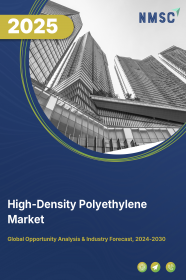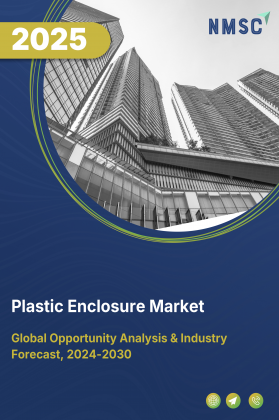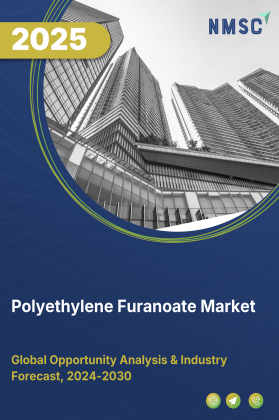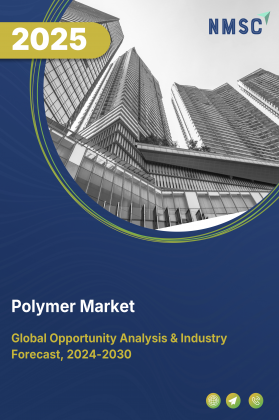
High-Density Polyethylene Market by Manufacturing Process (Phase Process, Slurry Process, Gas, and Solution Process), by Feedstock (Naphtha, Natural Gas, and Others), by Application (Film & Sheet, Injection Moulding, Blow Moulding, Pipes, Wire & Cables, and Others), by End-user (Packaging, Transportation, Building & Construction, Electrical & Electronics, Agriculture, and Industries & Machinery) - Global Opportunity Analysis and Industry Forecast 2022 – 2030
Market Definition
The High-density polyethylene market was valued at USD 68.82 billion in 2021 and is predicted to reach USD 96.50 billion by 2030 with a CAGR of 4.1% from 2022 to 2030.
High-density polyethylene (HDPE) is also known as alkathene or polythene when it is used for HDPE pipes. It is a thermoplastic polymer made from petroleum. HDPE has several properties such as high internal pressure to withstand external loads, high strength, and resilience to endure surges and water hammer pressure. HDPE is a Type 2 plastic and it is used in manufacturing containers for motor oil, soap bottles, shampoos & conditioners, detergents, milk, and bleaches. Moreover, the products that are made from Type 2 HDPE are environment-friendly and can be easily recyclable.
Market Dynamics and Trends
The increasing demand for high-density polyethylene is attributed to the proliferating use of HDPE pipes in agriculture for rural irrigation, fire system supply lines, and drainage pipes as these pipes are flexible and long-lasting. Also, surging demand for HDPE in the automotive industry for manufacturing batteries and various tanks that include oil, brake fluid, and washer fluid is driving the market. HDPE is used in manufacturing cars as it weighs less than the traditionally used materials in the automotive industry which is expected to support the growth of the market.
Moreover, the increasing deployment of HDPE in the food & beverage industry to make plastic bottles, caps, and containers drives the market growth. For instance, in May 2021, INEOS and LACTEL announced a partnership on advanced recycling packaging for dairy products. The partnership was aimed at creating the world’s first HDPE Milk Bottles. The companies launched 140,000 milk bottles, based on HDPE from advanced recycling technology.
In addition, the increasing use of HDPE in the electrical & electronics industry as they act as an insulator in various electrical equipment such as washing machines, microwave ovens, and kettles due to being unbreakable and lightweight is expected to further propel the growth of high-density polyethylene market.
The high manufacturing costs of high-density polyethylene along with the lack of skilled labors for its production are factors that are expected to restrain the growth of the market during the forecast period. On the contrary, HDPE plastic is the most environment-friendly of all plastics as it does not leak harmful chemicals into the soil or water, which is expected to create ample growth opportunities for the market in the coming years.
Market Segmentations and Scope of the Study
The high-density polyethylene market trends are segmented on the basis of manufacturing process, feedstock, application, end-user, and geography. On the basis of manufacturing process, the market is divided into phase process, slurry process, gas, and solution process. On the basis of feedstock, the market is bifurcated into naphtha, natural gas, and others. On the basis of application, the market is categorized into film & sheet, injection moulding, blow moulding, pipes, wire & cables, and others. On the basis of end-user, the market is divided into packaging, transportation, building & construction, electrical & electronics, agriculture, and industries & machinery. Based on building and construction, the market is sub segmented into residential and commercial. Further, on the basis of residential, the market is divided into row home, large apartment buildings, and independent homes. Based on commercial, the market is sub-classified into hospitals, schools, airports, and others. Geographic breakdown and analysis of each of the aforesaid segments include regions comprising North America, Europe, Asia-Pacific, and Row.
Geographical analysis
Asia-Pacific held the predominant share of the high-density polyethylene market in 2021 and is expected to continue its dominance during the forecast period. The increasing use of HDPE in the food & beverages industry for packaging various products such as bottle caps, bags, and food storage containers drives the HDPE market growth in the region. Therefore, various companies are acquiring niche companies to expand HDPE product offerings in newer markets.
For instance, in November 2021, IPackChem Group, the manufacturer of innovative plastic packaging products announced it had signed a definitive agreement with Mullackal Polymers Pvt Ltd. Through this acquisition, IPackChem planned to provide HDPE and barrier plastic containers, caps and measuring cups for India’s crop protection and specialty chemical industry.
Also, the rising number of online food delivery platforms that demand safe plastic for food along with the growth in the construction industry in Japan, China, and India, incorporating HDPE pipes for residential plumbing purposes are expected to drive the market growth in this region.
North America is expected to witness steady growth in the market during the forecast period, due to the presence of various key market players such as Dow and Chevron Phillips Chemical Company that are adopting various strategies to expand their businesses in this region.
For instance, in December 2021, Dow Plastics introduced a new line of DOW high-density polyethylene resins that offer industry-leading performance. This product allows pipe producers to meet or exceed all existing performance standards for polyethylene pressure pipe.
Also, HDPE possesses chemical-resistant properties that make it useful for the use of plastic caps & bottles, household cleaning products, motor oil, antifreeze, and recycling bins, which is expected to drive the high-density polyethylene market growth in this region.
For instance, in October 2020, Coca-Cola North America introduced an upgrade to sustainable packaging by using caps made from recycled HDPE plastic. The company and Coca-Cola Bottling Sales and Services worked closely with resin and closure suppliers to develop a cap made with recycled HDPE.
Competitive Landscape
The high-density polyethylene market comprises various market players such as INEOS, SABIC, Lyondell Basell Industries Holdings B.V., Dow, Chevron Phillips Chemical Company LLC, PetroChina Company Ltd., Braskem, Reliance Industries Limited., Formosa Plastics Corporation, and Daelim Co. Ltd among others. These market players are adopting various strategies such as acquisition and innovation of business across various regions to maintain their dominance in the high-density polyethylene market.
For instance, in November 2020, INEOS Olefins and Polymers USA announced that it had acquired Sasol Chemicals North America LLC to get its 50% membership interest in Gemini HDPE LLC. Gemini is a toll manufacturer of bimodal high-density polyethylene products serving the rapidly growing pipe and film markets.
Also, in August 2020, LyondellBasell announced that Duqm Refinery and Petrochemical Industries Company LLC had selected LyondellBasell’s world-leading polypropylene (PP) and HDPE technologies for a new facility. The new facility comprises a 280 KTA polypropylene plant that utilizes LyondellBasell’s Spheripol PP process technology and a 480 KTA high-density polyethylene plant.
Key Benefits
-
The high-density polyethylene market report provides a quantitative analysis of the current market and estimations through 2022-2030 that assists in identifying the prevailing market opportunities to capitalize on.
-
The study comprises a deep dive analysis of the trend including the current and future trends for depicting the prevalent investment pockets in the high-density polyethylene market.
-
The information related to key drivers, restraints, and opportunities and their impact on the high-density polyethylene market is provided in the report.
-
The competitive analysis of the market players along with their market share in the high-density polyethylene market
-
The SWOT analysis and Porter’s Five Forces model are elaborated in the study.
-
Value chain analysis in the market study provides a clear picture of the stakeholders’ roles.
Key Market Segments
By Manufacturing Process
-
Phase Process
-
Slurry Process
-
Gas
-
Solution Process
By Feedstock
-
Naphtha
-
Natural Gas
-
Others
By Application
-
Film and Sheet
-
Injection Moulding
-
Blow Moulding
-
Pipes
-
Wire & Cables
-
Others
By End-user
-
Packaging
-
Transportation
-
Building & Construction
-
Residential
-
Row Home
-
Large Apartment Buildings
-
Independent Homes.
-
-
Commercial
-
Hospitals
-
Schools
-
Airports
-
Others
-
-
Electrical & Electronics
-
Agriculture
-
Industries & Machinery
-
By Geography
-
North America
-
U.S
-
Canada
-
Mexico
-
-
Europe
-
UK
-
Germany
-
France
-
Italy
-
Spain
-
Rest of Europe
-
-
Asia-Pacific
-
China
-
India
-
Japan
-
South Korea
-
Australia
-
Rest of Asia-Pacific
-
-
RoW
-
UAE
-
Saudi Arabia
-
South Africa
-
Brazil
-
Remaining countries
-
Key Players
-
INEOS
-
SABIC
-
LyondellBasell Industries Holdings B.V.
-
Dow
-
Chevron Phillips Chemical Company LLC
-
PetroChina Company Ltd.
-
Braskem
-
Reliance Industries Limited
-
Formosa Plastics Corporation
-
Daelim Co., Ltd
REPORT SCOPE AND SEGMENTATION:
|
Parameters |
Details |
|
Analysis Period |
2021–2030 |
|
Base Year Considered |
2021 |
|
Forecast Period |
2022–2030 |
|
Market Size Estimation |
Billion (USD) |
|
Market Segmentation |
By Manufacturing Process (Phase Process, Slurry Process, Gas, Solution Process) By Feedstock (Naphtha, Natural Gas, Others) By Application (Film and Sheet, Injection Moulding, Blow Moulding, Pipes, Wire & Cables, Others) By End-user (Packaging, Transportation, Building & Construction, Electrical & Electronics, Agriculture, Industries & Machinery) |
|
Geographical Segmentation |
North America (U.S., Canada, Mexico) Europe (UK, Germany, France, Italy, Spain, Rest of Europe), Asia-Pacific (China, India, Japan, South Korea, Australia, Rest of Asia-Pacific), Rest of the World (UAE, Saudi Arabia, South Africa, Brazil, Remaining countries) |
|
Companies Profiled |
INEOS, SABIC, LyondellBasell Industries Holdings B.V., Dow, Chevron Phillips Chemical Company LLC, Borealis AG, Braskem, Reliance Industries Limited, Formosa Plastics Corporation, Daelim Co., Ltd |




















 Speak to Our Analyst
Speak to Our Analyst





















